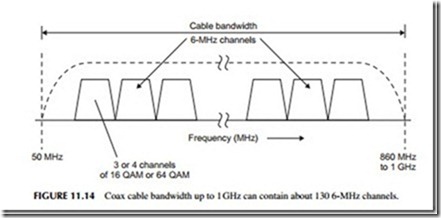CABLE TELEVISION
It is estimated that about 15% of all U.S. citizens get their TV over the air with an antenna. But over 70% get TV via cable. The remaining 15% get satellite TV. Why? Mainly because cable offers not only better, more reliable signals than by antenna, but also offers hundreds of channels of programming. But that’s not all. Most of those who have cable also use the cable connection for
high-speed Internet access service. Of course, you pay for all that, and it has become like a monthly utility bill. With the cable industry being so big, it pays to know a little more about it.
It all starts with a facility called the cable head end. Another name you might hear is cable modem termination system (CMTS), which specifically is the equipment at the head end. This is a place where the company collects video and programming from many different sources. It snatches signals off the air, it receives premium programming like HBO, ESPN, Showtime, and Fox via satellites, stores movies on its large computers called video servers, and may even do some of its own local programming. The result is a hundred channels or more.
Now each of those TV signals—video plus audio—is modulated onto carriers that are spaced 6 MHz apart just like the regular over-the-air TV channels. Then all of those modulated carriers are added together to form a very complex signal. That signal is then amplified and put on the outgoing cable. Figure 11.14 shows what the spectrum looks like. Most cables have a bandwidth from about 50 MHz up to about 860 MHz to 1 GHz, which will accommodate up to about 130 6-MHz channels. We call this process frequency-division multiplexing, where a single cable can carry many separate channels of data, each on a different frequency and bandwidth. And since the cable is shielded, it does not radiate, so it, in effect, duplicates the free-space electromagnetic spectrum.
Since most TV today is digital, digital modulation methods are used to put multiple TV signals within each 6-MHz channel. Using 16-QAM or 64-QAM, a cable company can squeeze several channels of video/audio into each 6-MHz chunk of spectrum, providing hundreds of additional slots for programming. That is why cable companies can advertise up to 500 channels of entertainment, news, and so on.
All of the digital video/audio signals are then remodulated onto different channel assignments. All of these 6-MHz channels are added together or linearly mixed in a multiplexer (MUX) to create a massively complex compos- ite signal. This is what goes out on the cable (see Figure 11.15).
The signal distribution network is called a hybrid fiber cable (HFC) system. This multiplexed signal is applied to a fiber optic cable, called a trunk cable. It is routed around the city and it terminates at selected points where the signal is divided into multiple paths of coax cable. These so-called feeder cables are connected to amplifiers along the way to overcome the large attenuation of the cables. At some point, the feeder cables come into your neighborhood and are further amplified and split into multiple signals. These signals are then sent to your house by a coax drop cable. The most common type is 75-ohm RG-6/U coax with F-connectors. The cable comes into your home and is usually split two or more times and sent to wall connectors in the various rooms. These connectors connect the signal to a cable box and/or a cable modem for the PC. The cable box is like a tuner in that its main job is to select one of the many channels and send it to your TV set. Figure 11.16 shows a simplified block diagram of a typical cable box, usually called a set-top box (STB). The input is a TV tuner with channel selection via a frequency-synthesizer local oscillator by way of your remote control. The selected signal is then demodulated and decompressed by a digital media processor chip, and then sent to the TV set via one of the many possible interfaces, usually the HDMI or high-definition multi- media interface. This is a very fast digital interface with special cable and con- nector. Most TV sets have this as the most common input. Other video format interfaces such as RGB, PrPbPy, or S-video, are usually provided to accommo- date older analog TV sets. An additional feature of many of the newer STBs is a built-in digital video recorder (DVR). This is essentially a computer hard disc
drive that records the program you want to save for viewing later.
 For Internet access, you connect a cable modem to the coax cable and it automatically selects the channel where the data services are assigned. The modem goes to your computer via an Ethernet cable. Access to the Internet is by way of your computer’s browser.
For Internet access, you connect a cable modem to the coax cable and it automatically selects the channel where the data services are assigned. The modem goes to your computer via an Ethernet cable. Access to the Internet is by way of your computer’s browser.


